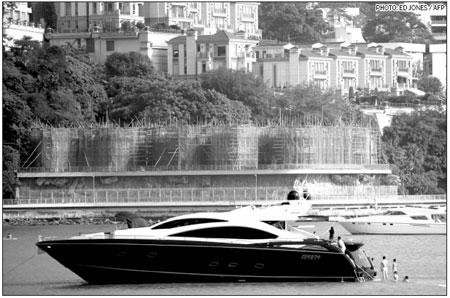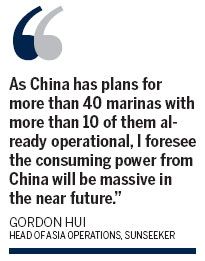Growing yacht industry has some wind in its sales
Updated: 2011-06-15 07:42
By Emma An(HK Edition)
|
|||||||


China has been keeping up with the West on almost every front it seems. And these days, the country's super rich have found one more area where they can do a little bit more catch-up work - yachting. The culture of yachting, a major pastime among affluent Americans and Europeans, is now taking hold in China as the mainland's nouveau riche increasingly spend their weekends cruising up and down various waterfronts.
As such, expensive private yachts are the most recent must-have item for many of the nation's well-heeled - right up there with a fancy home, designer labels such as Louis Vuitton, and a fast sports car like a Porsche.
Demand for private yachts has gained traction in China over the past two years although the country still makes up only 1-2 percent of the global yacht market currently.
But yacht makers are racing to fill that demand, hoping to make up lost ground to the US and Europe, traditionally the industry's two most important markets. The two markets put together still account for 95 percent of yacht sales globally, but growth has slowed due to having been deeply mired in the global recession.
"The financial crisis has definitely affected the yachts market," Gordon Hui, who heads the Asia operations of the famed UK yacht brand Sunseeker, told China Daily.
But "China recovered rapidly from the financial crisis," Hui added, "and the market for yachts expanded as a result. It has also propped up the whole Asia market."
In the four years from 2006 to 2010, China's yacht industry has gone from virtually zero to attaining a market size worth about $3.4 billion. However, some industry insiders say that the yachting market in China could balloon to 200 billion yuan ($30.86 billion) over the next few years.
US-based Brunswick Corp, the maker of Boston Whaler fishing boats, said total yacht sales in China could grow by as much as 25 percent this year.
"We believe the long-term potential in the marine business is larger than anywhere else in the world," Chief Executive Dustan McCoy told Bloomberg recently.
Sunseeker's Hui sees China's yacht market "in full swing by next year".
Samuel Wong, a Hong Kong-based yacht builder, was even bolder in his outlook. He expects the market on the mainland to double in just one year. So far, it has consumed half of the yachts churned out by Wong's shipyard.
Wong, who expects to deliver his most expensive boat into the hands of a mainland owner soon, said his yacht is cheap compared with a similar model made by a foreign yacht maker. One yacht he had just sold on the day China Daily caught up with him carried a price tag of 38 million yuan.
Meanwhile, William Hung, a marketing consultant at Taiwan-based luxury yacht maker Horizen, says that brand recognition plays a large part in what type of yacht wealthy mainlanders are likely to buy, just as they would when buying a luxury watch.
In part, this is because people on the mainland still "don't know much about yachts and sailing", Hung said.
Thus you have situations where a foreign-made boat can cost as much as hundreds of thousands of dollars more than a domestically-manufactured one even if the two are essentially 80 percent similar in terms of design and quality, he added.
And the super rich yacht buyers do care a great deal about whether the boat is British-made or an Italian-made, a view which Wong shares with Hung.
But that doesn't mean Chinese yacht makers have been completely shut out of the market. Quite the contrary in fact as China's yacht exports are steadily increasing from $180 million in 2006 to $220 in 2007 and further to $260 million in 2008. The momentum was lost in 2009 following the outbreak of the global financial crisis but regained its footing in 2010, during which $204 million worth of yachts were exported.
At this year's Hong Kong Gold Coast Show in May, which attracted 20,000 visitors, there was no lack of well-off Chinese who ended up buying a domestically-manufactured boat selling for somewhere between HK$200,000 and HK$1 million.
The sport of sailing is increasingly in vogue among not just the super rich but also China's emerging middle class. So a lot of buyers are looking for a bargain when it comes to boats. And even if they don't have pockets deep enoughto splurge on a yacht akin to a Rolls-Royce, owning a BMW or a Mercedes-Benz will suit them just fine.Yacht makers are exerting more effort than ever to cater to this rapidly expanding legion of rich Chinese who often don't use their yachts the same way the Europeans or Americans do.
For them, a boat is used to entertain clients rather than for sailing. Thus a flat-screen television, a Karaoke and a games room are usually must-haves, said one domestic yacht maker who participated in the Hong Kong Gold Coast show.
For corporate buyers, they use their boats to do social networking for the sake of their businesses.
Foreign boat makers have taken note of this and have been rushing to unveil models with touches tailored for Chinese tastes at boat shows across the country.
According to the 2010 Hurun Wealth report, there are now 875,000 millionaires (people with financial assets in excess of 1 million yuan) in China in US dollar terms, and half of them have indicated they intend to own a private yacht.
In anticipation of this exponential growth, Sunseeker Asia is looking to double the number of dealers in China to eight from four currently.
"As China has plans for more than 40 marinas with more than 10 of them already operational, I foresee the consuming power from China will be massive in the near future," said Hui.
The sector has received considerable backing from the government lately, with restrictions eased and more go-aheads given. The allure is not just about a huge wealth-creating industry, but an entire yacht industry chain. For example, there will be the growth of yacht clubs, which offer services such as yacht maintenance and crew training. There are about 40 yacht clubs in China at the moment, and the trade is lucrative given exorbitant membership and annual fees. One has to pay around 200,000 yuan to be a club member.
Meanwhile, Shanghai is aiming at being the largest yacht production base in China, while Tianjin, where a 9-billion yuan yacht port is currently under construction, plans to become the center of the yacht industry in North China.
Qingdao, which hosted the sailing competition during the Beijing 2008 Summer Olympic Games, has seen 40 shipyards set up in just the past year alone.
And finally, there is Hainan Island. Touted as China's playground for the rich, the place has the best climate and marinas for sailing, according to Horizen's Hung. There are currently more than 1,000 yachts officially registered on the mainland, and 37 percent of the most expensive ones are docked at one of Hainan's five yachting clubs.
But the common problem they all share is a lack of suitable marinas and berths. Even in Hainan, sailing activities remain centered in and around Sanya, the main resort area.
Smooth sailing is also made difficult by government rules which restrict where boats can sail in China, thus yacht owners need special permits to travel on their boats from province to province.
Yet, for yacht buyers and makers alike, what they would most like to see are reduced duties on imported boats - which currently stand at a stiff 43 percent. Hong Kong boatmaker Samuel Wong sees the high tax as the biggest barrier to the growth of China's yacht market, and which explains why so many mainland sailors have registered and anchored their newly-bought yachts in Hong Kong. And the number is growing fast.
(HK Edition 06/15/2011 page2)